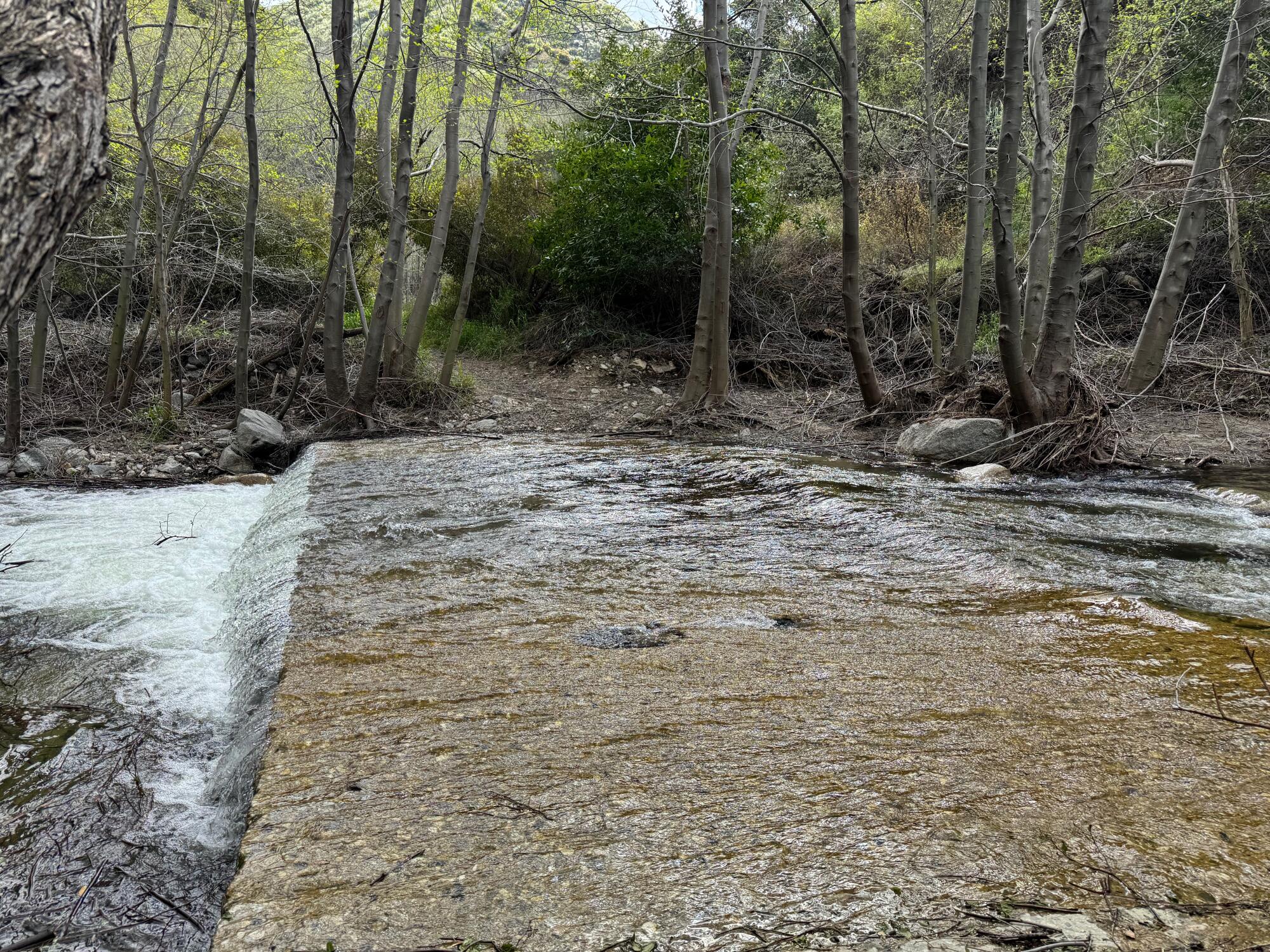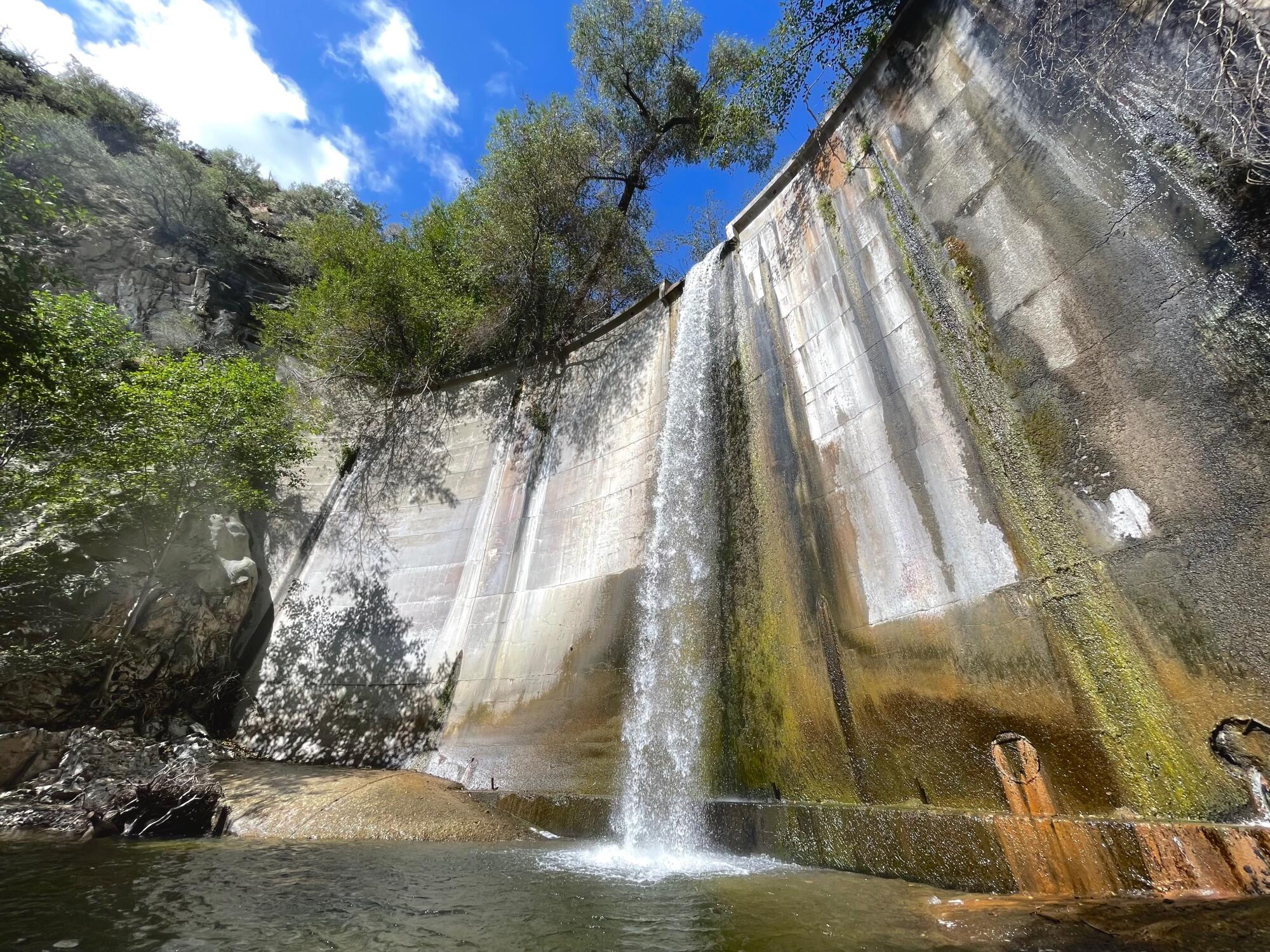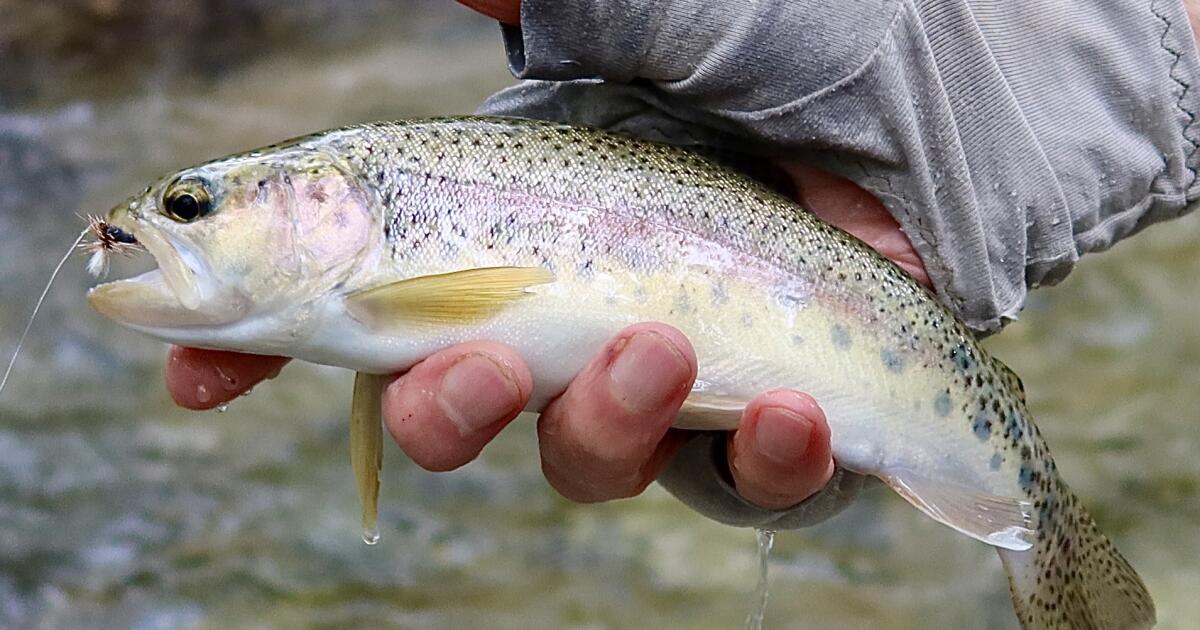Removing man-made barriers in a major tributary of the Los Angeles River could provide a lifeline for native trout — most, if not all, of which were rescued from a destructive 2020 fire — according to a new report.
A presentation of the findings last week by environmental consultant Stillwater Sciences called for taking out three impediments in a stretch of the Arroyo Seco that restrict the movement of the trout, potentially cutting them off from spawning areas or refuge from drought.
For the record:
2:57 p.m. July 31, 2024A previous version of this article credited the main image to the wrong photographer. The correct photographer is Darrell Kunitomi, The Times’ historian, who is a member of the Arroyo Seco Foundation.
The nonprofit Arroyo Seco Foundation commissioned the research as part of a multiyear project to improve the flow of the winding creek and benefit an endangered species of trout.
“We want to maintain biodiversity and try to use nature-based solutions where we can,” said Robert Kurkjian, president of the Arroyo Seco Foundation. “So the idea is to remove some of these barriers so the fish can move up and down the stream as necessary to survive.”
Climate change has added urgency. Hemmed in, the fish could face a dire situation if a wildfire dumped ash into the water or a prolonged drought evaporated their home.
“Basically, it’s like us: If there’s a fire, we can move to a safe spot,” said Sandra Jacobson, director for California Trout’s South Coast and Sierra regions, who said more watery real estate also means the trout’s population can expand.
Though the trout currently inhabiting the Upper Arroyo Seco aren’t protected by state or federal regulations, they could be — if they were able to reach the ocean.
They’re rainbow trout, the same species as a Southern California population of steelhead trout that in April was listed under the state Endangered Species Act. The difference is that steelhead migrate to the ocean whereas rainbow trout don’t.
In this case, the trout almost certainly can’t reach the ocean — even though some may try — because of the trappings of urbanization. Even if they somehow made it through, they can’t swim back.
And they’ve endured other hardships. The population in the stream that snakes past the Jet Propulsion Laboratory in La Cañada Flintridge was nearly wiped out by the 2009 Station fire, according to a June report by Stillwater. Then state wildlife officials moved in 469 rainbows rescued from the San Gabriel River watershed, which biologists feared would perish in the aftermath of the Bobcat fire of 2020.
Today there are about 4,000 rainbows inhabiting the Upper Arroyo Seco, a portion of the waterway upstream of the Devil’s Gate Dam near the 210 Freeway, according to a recent survey by the California Department of Fish and Wildlife. In Southern California, they’re fairly small, generally about 4 to 12 inches, according to Jacobson. (The small percentage that migrate to the ocean, when conditions permit, grow larger.) They’re associated with a red or pink stripe on their side.
Although the Upper Arroyo Seco population is sizable, it’s still vulnerable. We’ve had several good water years, but drought or other threats could be around the corner.
“They’re stranded and trapped” — there’s the concrete-lined L.A. River and the daunting Brown Mountain and Devil’s Gate dams, Kurkjian said. “And they have these pools which they need to survive in.”
A similar story has played out across the region. California’s rivers were once teeming with silvery steelhead, but habitat loss and fragmentation has helped push them to the brink of extinction.
“It’s really a long-term vision to bring steehead back,” said Matt Drenner, senior fisheries biologist for Stillwater. “So right now it’s like, let’s make sure the current existing population can make it to when they have access to the ocean again.”

So-called Arizona crossings installed across the upper Arroyo Seco were once used to help firefighting efforts but are no longer used for that purpose.
(Danielle Yaconelli / Stillwater Sciences)
To that end, Drenner’s team advocated for the removal of two concrete pads known as Arizona crossings and one U.S. Geological Survey gage to make it easier for the rainbows to move. The report recommends doing away with other impediments, but these three — which sit within prime rainbow habitat — were deemed high priority.
The Arizona crossings resemble a wide sidewalk, stretching from one bank of the waterway to the other. The U.S. Forest Service once used the pads for wildfire control but no longer does, according to a news release.
The gage was installed many years ago to measure water conditions, the release said.
Jacobson, who was not involved in the study, said the approach makes sense.
“I think this is a pretty good approach to increase the habitat accessibility for trout and other native species too,” said Jacobson, who is involved with steelhead recovery efforts.

Dams along the Arroyo Seco, including the Brown Mountain Dam, hinder trout from moving around as they did before urbanization changed wild landscapes. Trout can’t swim upstream of Brown Mountain, where researchers believe there’s good habitat.
(Robert Kurkjian / Arroyo Seco Foundation)
Stillwater’s study identified and assessed 12 barriers to streamflow in the area. Devil’s Gate and Brown Mountain dams were not assessed in the report.
Fish can “spill over” Devil’s Gate, but they cannot come back up the river, Drenner said. Surveys haven’t shown any fish living directly above Brown Mountain, but it’s blocking those below from getting upstream of it, where Drenner believes there’s excellent habitat.
Kurkjian indicated that potential removal of the dams — major barriers for the fish — needed to be studied separately. The foundation commissioned an early-stage assessment of what it would take to remove Brown Mountain.
He said removing the smaller barriers will be challenging too, particularly given the number of agencies involved. Funding, often elusive, would need to be nailed down and permits pulled. Coordination would be required between local, state and federal partners, including the city of Pasadena, L.A. County, the California Department of Fish and Wildlife, the U.S. Forest Service, U.S. Fish and Wildlife, the U.S. Geological Survey and the U.S. Army Corp of Engineers.
There is evidence that barrier removal can pay off. Cleveland National Forest removed 81 check dams in several creeks in the mountains of Orange County. Shortly after some removals, arroyo chub, another native fish, started moving upstream, Jacobson said.
“All of a sudden, they could move into new habitat that they didn’t have access to for a long time,” she said.
